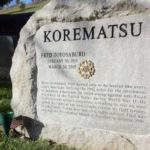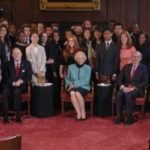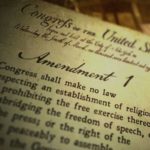On December 18, 1944, the U.S. Supreme Court handed down one of its most controversial decisions when it upheld the government’s decision to intern all persons of Japanese ancestry (both alien and nonalien) on the grounds of national security. Over two-thirds of the Japanese in America were citizens and the internment took away their constitutional rights. In this lesson, students evaluate the consequences of past events and decisions related to the Supreme Court case Korematsu v. United States (1944). They consider the challenges involved when trying to balance civil liberties and national security during threatening times and reflect on the lessons learned about civil liberties from the justices in the Korematsu case.
Search and Seizure Cartoon Analysis
Spark a conversation about the balance between national security and Fourth Amendment rights with this quick cartoon of Lady Liberty.
Voices of History
Voices of History is a collection of eight Bill of Rights Institute curriculum resources including Being An American, Preserving the Bill of Rights, Founders and the Constitution, Supreme Court DBQs, Liberty and Security in Modern Times, Religious Liberty: An American Experiment, and Heroes and Villains. Teachers will have free access to each resources’ lessons plans and handouts.
Rights at Risk in Wartime
The terrorist attacks on Sept. 11, 2001, stunned the nation. As commander-in-chief, President George W. Bush responded quickly but soon all three branches of government would be embroiled in the struggle to balance national security with the protection of individual liberties amid a war on terror. This lesson plan is based on the Annenberg Classroom video “Habeas Corpus: The Guantanamo Cases.” The four cases are examples of how the Supreme Court, the president and Congress fought to balance national security and civil liberties during the war on terror. At the heart of each case was the constitutional right of habeas corpus, the right to have one’s detention or imprisonment reviewed in court.
Korematsu and Civil Liberties

This documentary explores the landmark case Korematsu v. U.S. (1944) concerning the constitutionality of presidential executive order 9066 during World War II that gave the U.S. military the power to ban thousands of American citizens of Japanese ancestry from areas considered important to national security. A PDF lesson plan accompanies this video.
A Conversation on the Importance of the Japanese Internment Cases

Justices Stephen G. Breyer, Sandra Day O’Connor and Anthony M. Kennedy discuss two landmark cases, Korematsu v. U.S. and Hirabayashi v. U.S., in which the Supreme Court tried to strike a balance between individual rights and national security during wartime. The cases stem from President Franklin Roosevelt’s 1942 executive order that mandated the relocation of Japanese and Japanese Americans to internment camps. This video complements the documentary Korematsu and Civil Liberties.
Documents of Freedom: History, Government, and Economics Through Primary Sources

This complete online textbook covers American history, government, and economic concepts. Resources include readings for students, activity directions for teachers, and handouts that are downloadable and printable for classroom use. Content is geared toward students in grades 8-12. All materials are aligned with Common Core and individual state standards.
Defenders of Liberty: The People and the Press
This lesson plan is based on the Annenberg Classroom video “Freedom of the Press: New York Times v. U.S.,” which explores the First Amendment’s protection of a free press as well as the historic origins of this right and the ramifications of the landmark ruling in the Pentagon Papers case in which the Supreme Court ruled that prior restraint is unconstitutional.
The Purposes of Government
This lesson has students learn about the purposes of government specified in the preamble of the Constitution. Students will use C-SPAN video clips to define what is meant by “establish Justice, insure domestic Tranquility, provide for the common defense, promote the general Welfare, and secure the Blessings of Liberty.” As practice, students will apply their knowledge of these purposes by viewing real-life examples of government actions and identifying the relevant purpose of government. This lesson works well in classrooms with one-to-one devices and can be adapted to flipped classrooms.
Freedom of the Press: New York Times v. United States

This documentary examines the First Amendment’s protection of a free press as well as the historic origins of this right and the ramifications of the landmark ruling in New York Times v. United States in which the Supreme Court that prior restraint is unconstitutional. The federal government could not prevent newspapers from publishing the Pentagon Papers. A lesson plan, Defenders of Liberty: The People and the Press, accompanies the video.